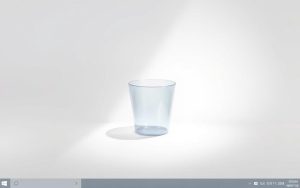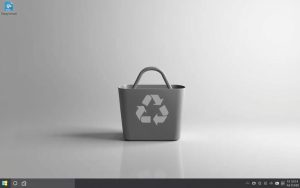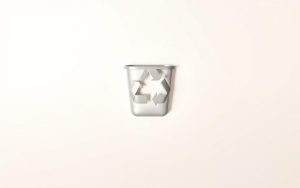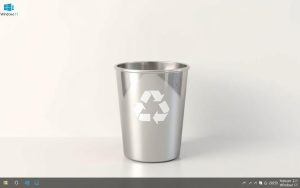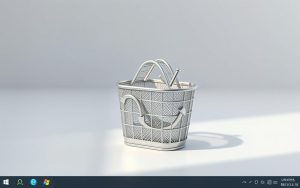Table of Contents
Customizing your desktop can make your computer experience more personal and efficient. One way to achieve this is by modifying the appearance of default icons, such as the Recycle Bin. Whether you want a fresh look or better organization, Windows provides tools to help you achieve this.
Windows 10 and 11 offer built-in options to adjust icons through the Settings app, Run command, or Registry Editor. Each method is straightforward, but it’s essential to follow safety precautions, especially when editing the registry. Backing up your system is highly recommended to avoid potential issues.
This tutorial will guide you through the process, ensuring your desktop reflects your style while maintaining functionality. Let’s explore the steps to give your Recycle Bin a new look!
Introduction to Customizing Your Recycle Bin Icon
Personalizing your desktop icons can enhance your computer experience. The default setup in Windows includes essential icons like the Recycle Bin, This PC, Network, and User’s Files. While these serve functional purposes, customizing their appearance can make your desktop more visually appealing and efficient.
The Recycle Bin plays a crucial role in managing deleted files, but its aesthetic can be tailored to match your style. Windows allows separate icons for full and empty states, adding a layer of personalization. However, themes can override custom icons unless settings are adjusted to lock preferences.
Here are some key considerations when modifying your desktop icons:
- Understand the functional purpose of the Recycle Bin versus aesthetic needs.
- Be aware of theme compatibility issues and how to prevent overrides.
- Explore the benefits of personalization for optimizing workflow.
- Ensure your device meets system requirements for version-specific features.
While customization is straightforward, it’s essential to follow proper methods, especially when using advanced tools like the Registry Editor. Backing up your system is a recommended precaution to avoid potential risks. For a detailed guide on this process, check out this resource.
How to Change the Recycle Bin Icon Using Settings
Adjusting your desktop’s appearance can enhance your workflow and reflect your style. Windows provides built-in tools to modify default icons, making it easy to create a personalized environment. This method is ideal for users who prefer a straightforward approach without advanced technical steps.
![]()
Step 1: Accessing Desktop Icon Settings
Start by pressing Win+I to open the Settings app. Navigate to Personalization, then select Themes. Scroll down and click on Desktop icon settings. This section allows you to manage the visibility and appearance of default icons on your desktop.
Here, you can toggle the display of icons like This PC, Network, and User’s Files. Ensure the Recycle Bin option is checked to keep it visible. This step ensures your desktop remains functional while you proceed with customization.
Step 2: Selecting and Changing the Icon
In the Desktop icon settings window, click on the Recycle Bin and select Change Icon. A library of default icons will appear, offering various options for both full and empty states. Choose an icon that suits your style and click OK to apply the changes.
If you prefer to restore the original icon, simply click Restore Default. Additionally, uncheck the option Allow themes to change icons to prevent future overrides. This ensures your customization remains intact even after applying new themes.
For troubleshooting, ensure your device is updated to the latest Windows version. If issues persist, restarting the Settings app or your computer often resolves minor glitches. This method is a safe and effective way to personalize your desktop without compromising system stability.
Alternative Methods to Change the Recycle Bin Icon
For users seeking deeper customization, alternative methods are available. These techniques are ideal for advanced users or system administrators who want more control over their desktop appearance. While these methods require technical knowledge, they offer greater flexibility and permanence.
Using the Run Command
The Run command is a quick way to access advanced settings. To begin, press Win+R and type shell32.dll,Control_RunDLL desk.cpl,,0. This opens the Desktop Icon Settings window, where you can modify the appearance of default icons.
Select the Recycle Bin and click Change Icon. Choose from the available options or browse for custom .ico files. This method is efficient but requires precise syntax to avoid errors. Always double-check the command before execution.
Editing the Registry
For those comfortable with advanced tools, the Registry Editor offers complete control. Open the editor by typing regedit in the Run command. Navigate to HKEY_CURRENT_USER\Software\Microsoft\Windows\CurrentVersion\Explorer\CLSID\{645FF040-5081-101B-9F08-00AA002F954E}\DefaultIcon.
Modify the Default value to point to your desired .ico file. This method ensures permanent changes but carries risks if not done correctly. Always back up your registry before making adjustments.
After completing these steps, restart your computer to apply the changes. Both methods provide reliable results, but the Registry Editor offers greater permanence. Choose the approach that best suits your technical expertise and needs.
Conclusion
Exploring customization options can transform your computer experience. Whether you prefer simple adjustments or advanced techniques, Windows offers tools to suit every skill level. For beginners, the Settings app provides a quick and safe way to modify your device. Advanced users can leverage the Run command or Registry Editor for deeper control.
To maintain your customizations, avoid theme overrides and keep your system updated. Regular backups ensure your settings remain intact. For more inspiration, explore web resources and tutorials on icon creation and personalization.
Remember, system updates can sometimes reset configurations. Stay informed about news and updates to preserve your setup. If you encounter issues, seek help from online communities or support forums.
Take this time to experiment and make your home screen truly yours. Share your feedback and experiences to help others in their customization journey.
FAQ
Can I customize the Recycle Bin icon on my desktop?
Yes, you can personalize the Recycle Bin icon through the desktop icon settings or alternative methods like the Run command or registry editing.
Is it safe to edit the Windows Registry to modify the Recycle Bin icon?
Editing the registry can be risky if done incorrectly. Always back up your registry before making changes to avoid potential system issues.
Will changing the Recycle Bin icon affect my files?
No, modifying the icon does not impact your files or the functionality of the Recycle Bin. It’s purely a visual customization.
Can I revert to the default Recycle Bin icon after customization?
Yes, you can restore the default icon by accessing the desktop icon settings and selecting the original option.
Are there third-party tools available for changing the Recycle Bin icon?
Yes, several third-party applications allow for advanced customization of desktop icons, including the Recycle Bin.
Do I need administrative privileges to change the Recycle Bin icon?
Yes, administrative rights are required for certain methods, such as editing the registry or using the Run command.


